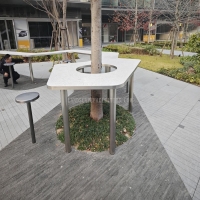Welcome to the website for landscape facilities products and knowledge.
How does the table’s design accommodate the needs of users with specific acoustic preferences?
Modern table designs have evolved beyond mere functional surfaces to become sophisticated acoustic solutions that actively address users' auditory needs. The integration of sound-absorbing materials represents a fundamental approach, where tables incorporate specialized fabrics, perforated wood composites, or recycled polyester fibers that capture and dissipate sound waves. These materials are strategically placed within table legs, undersurfaces, and paneling to create effective noise reduction zones.
For users requiring customizable acoustic environments, manufacturers now offer tables with modular acoustic panels that can be rearranged or replaced according to changing preferences. These panels employ varying densities of foam and batting materials, allowing users to control sound reflection and absorption ratios. Some premium models even feature electronically adjustable acoustic properties, where embedded micro-perforations can be mechanically opened or closed to modify sound transmission characteristics.
The physical architecture of tables also contributes significantly to acoustic performance. Designers incorporate wave-diffusing patterns on table edges and surfaces that break up sound reflections, while strategically angled legs and supports help redirect unwanted noise away from users. Hollow structural elements are often filled with acoustic damping materials that prevent sound amplification through vibration.
Height-adjustable tables present additional acoustic considerations, with manufacturers implementing silent motor systems and vibration-dampening mechanisms to ensure that positional changes occur without introducing disruptive noise. Cable management systems have been acoustically optimized too, using rubberized channels and fabric wraps to prevent rattling and vibration sounds from electronic devices.
Advanced tables now incorporate active noise cancellation technology in their designs, particularly for high-concentration environments. These systems use embedded microphones to detect ambient noise and generate counter-frequencies through small transducers installed within the table structure. Users can typically adjust these systems through discreet control panels or mobile applications to fine-tune their acoustic environment.
The growing recognition of neurodiversity in workspace design has further driven acoustic table innovation. Manufacturers are developing tables with multiple "acoustic zones" that accommodate different sensitivity levels within shared environments. These designs might feature one side with highly sound-absorbent properties for noise-sensitive users, while another side incorporates slightly reflective surfaces for those who prefer some auditory feedback during work.
Material selection plays a crucial role in meeting specific acoustic preferences. Natural wood surfaces provide warm, high-frequency absorption, while metal composites offer more reflective properties for users who prefer auditory stimulation. The thickness and density of table surfaces are precisely engineered to target specific frequency ranges, with some specialized tables featuring tunable resonant chambers that can be adjusted to absorb particular bothersome frequencies.
Ultimately, contemporary table design demonstrates remarkable sophistication in addressing acoustic preferences through multiple integrated approaches. From passive absorption techniques to active noise control systems, these furniture pieces have become essential tools for creating personalized auditory environments that support productivity, comfort, and wellbeing across diverse user populations and workspace configurations.
Related search:

Recommendation
An outdoor bar counter with stainless steel and terrazzo materials in an irregular shape